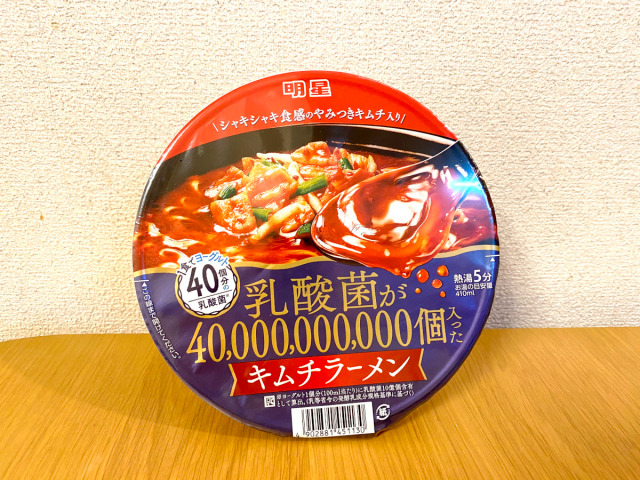
I demand a recount!
With so many varieties of instant noodles on the market, it can be very hard to stand out. Even its leader Cup Noodle strives to be increasingly outlandish, making it that much harder for competitors to get noticed. Meisei, however, may have found an in with their new Kimchi Ramen with 40,000,000,000 Lactic Acid Bacteria.
Released on 23 November, this spicy soup is hoping to cash in on the wild popularity of other lactic-acid-bacteria-rich Japanese products in the past. They are also taking things one step further by providing an estimated bacterium population on the label.
It’s a neat trick, because why say your food has “such-and-such grams” of a nutrient when you can say it has “BILLIONS of molecules” of it instead?
However, people in other countries might not be so familiar with the appeal of lactic acid bacteria that seems to drive Japanese consumers wild. In fact, our taste-tester P.K. Sanjun wasn’t sure either, so he consulted the Ministry of Health, Labor and Welfare website to learn more about it.
“Lactic acid bacteria play a role in suppressing the growth of harmful bacteria such as E. coli in the intestine and balances intestinal bacteria levels. It is said to not only improve bowel movements, but also lower cholesterol and enhance immunity against cancer. Lactic acid bacteria’s role in eliminating H. pylori infections in the stomach is also currently being studied.”
[Ministry of Health, Labor and Welfare]
Sounds great, but there’s also the question of whether 40 billion bacteria is actually a lot, considering they’re microscopic. So, to clarify, Meisei wrote on the package that one bowl of their new Kimchi Ramen has the same amount of lactic acid bacteria as 40 cups of yogurt.
P.K. was intrigued at what such a bacteria-ridden ramen might taste like, so he happily paid the 230 yen (US$2.20) price of admission and started boiling some water. The contents were underwhelmingly similar to a regular instant noodle kit with dried noodles, toppings, and sauces. No pulsating packages of 40 billion bacteria, or anything to even suggest such.
Once completed, there still was nothing distinguishing this from an ordinary bowl of kimchi ramen. Even though bacteria are invisible to the naked eye, so many in such a small space would make their presence known somehow, wouldn’t they?
Even while eating, there was nothing outstandingly different about this ramen. It was tasty, but well in the neighborhood of other instant ramens. P.K. had thought that for sure the lactic acid bacteria would have given it a milkier taste or texture, but nothing out of the ordinary could be detected.
Still, as he ate, P.K. knew he was getting a heap of healthy bacteria, and that motivated him to keep eating. He even drank the last drop of broth, just in case those little things were hiding in there.
All in all, in wasn’t anything amazing, but that’s par for the course with instant ramen. And while you might say that this product isn’t about the taste but the health benefits, P.K. couldn’t help but think that you could get the same amount of lactic acid bacteria in a simple little bottle of the drink Yakult 400.
However, if you want your 40 billion bacteria and to eat kimchi ramen too, this product has all your bases covered. Considering the bacteria help promote smooth bowel movements, they ought to conveniently counteract the kimchi in that regard.
P.K. was far too modest to tell us if that was the case or not though. Maybe we’ll ask one of our more forthcoming reporters to describe that end of the experience later on.
Source: Meisei, Ministry of Health, Labor and Welfare
Photos ©SoraNews24
● Want to hear about SoraNews24’s latest articles as soon as they’re published? Follow us on Facebook and Twitter!
[ Read in Japanese ]